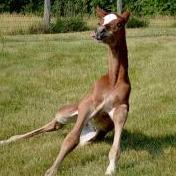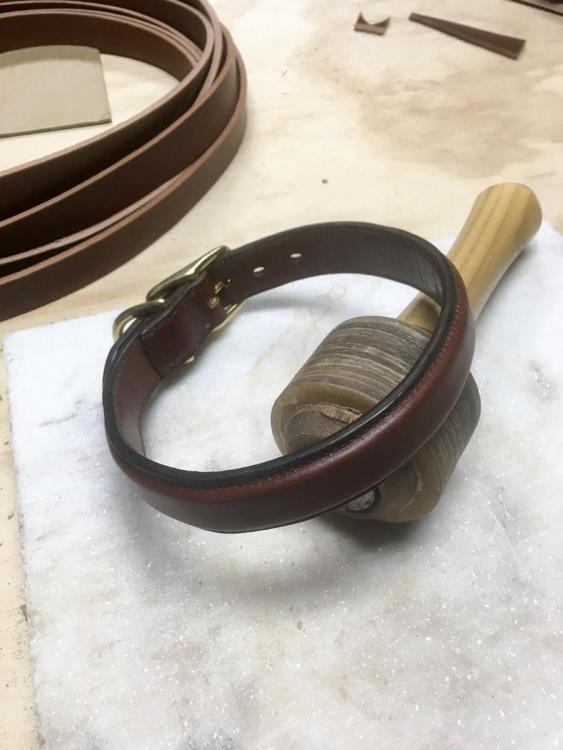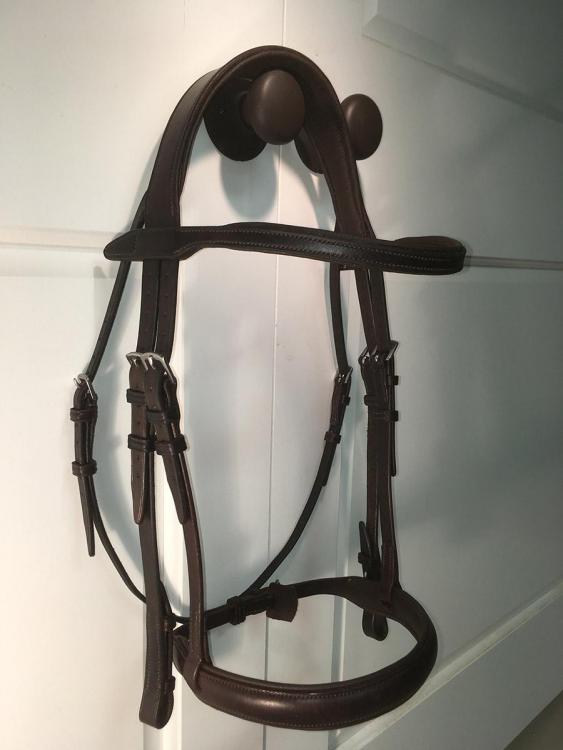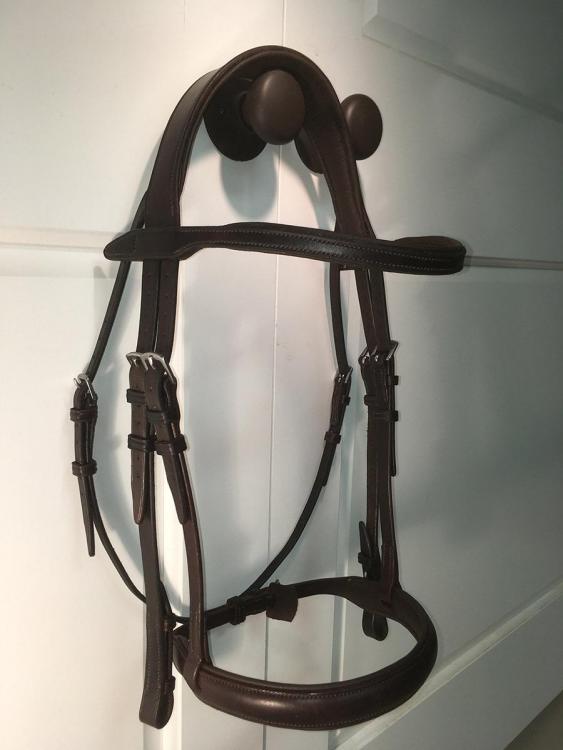-
Posts
1,282 -
Joined
-
Last visited
Content Type
Profiles
Forums
Events
Blogs
Gallery
Everything posted by TomE
-
How fun is that? Perfect!
-
Wow! Congratulations on 2 passages. That must be incredible. My only journey today is walking from the house to the barn -3 times.
-
I like tracing from a printed page as you're doing. I don't cut out the pattern. Just sketch over the printed pattern on lightly cased leather then clean up the lines with a pen or pencil before cutting. I usually do a bit of shaping with a drum sander to fix my mistakes.
-
Campbell Randall sells Colorfast dye. Springfield Leather sells Fenice Diamond Water Stain (?) that looks like a similar product. They have a Youtube video about it.
- 6 replies
-
- heated edge paint
- dog collar
-
(and 2 more)
Tagged with:
-
I have the best results burnishing bridle leather using canvas and saddle soap. I made a canvas sleeve for the sanding drum on my burnisher. For tack, I dye the edges with Fiebings Pro Dye or Fenice Colorfast dye. The Colorfast dye has "waxes and binders" that produce a reasonably shiny edge as seen in this dog collar.
- 6 replies
-
- heated edge paint
- dog collar
-
(and 2 more)
Tagged with:
-
That's some nice machining. You must have quite a shop. Does it work for alcohol based dyes?
-
My strategy is to hoard what I need. Weaver Leather Supply has good email notification when a backordered item becomes available - I snap up a few dozen. My favorite vendor for heavy brass and stainless hardware - Batz Corp - is not long on customer service so I regularly troll their online store to check status. Using the broken supply chain as an excuse to learn some new tricks.
-
I would skip the glue because it will be easier to line up the holes when stitching. The stitches will be plenty strong. If its difficult to insert a harness needle through the existing hole then a sewing awl is a useful probe. I'd be using #207 (0.02") or #277 (0.023") bonded nylon thread and backstitching 2-1/2 stitches to put both ends on the backside. Trim the ends close, wave a lighter at the ends to seal them, and tuck each end into a hole using a fid (blunt awl). I'd apply a light coat of neatsfoot oil, let it soak in for a day, and apply another coat if it needs it. Leather balms like Fiebings Aussie Conditioner work well for me.
-
@Jax may I ask about your setup for sewing rubber rein grips? I just bought a pile from Abbey England and was debating whether to sew the grips on nylon straps by hand or use a machine. Some old books recommend a pop stitch sewn by hand. Advice on thread weight, needle type, and stitch length appreciated.
-
I'll bet he's pleased with it. Worthy of a real man who sews.
-
I agree with continuing to clean with a mild soap. Maybe the saddle is clean enough to use and she can work on it again later. I swipe a damp sponge over a bar of glycerin saddle soap, just enough to create some suds, and rinse the sponge often in a bucket of clean water. After cleaning, I wipe with a damp sponge to remove soap residue and let it dry as per @Mulesaw's directions. Takes time to clean years of neglect.
-
You might email or call Hermann Oak Leather Co. I've found them very responsive and would think they'd be concerned about that hide representing their product. About a year ago they had production problems because of a splitter that was off line for several weeks, and SLC was short on quality product. I ended up keeping a side that had a lot of puckering because it was all that was available. A few weeks ago, HO told me they were at maximum production capacity and not taking on new customers at this time.
-
To Change Motor Speed and/or Rotation of Motor (printed page included with my Cobra 4) 1. Hold down the button on the control panel until the display reads "S.0" The S looks like a 5. 2. Press the up button 2 times until the display reads "S.2" 3. Press the down button once and the up button once, and the motor will then be set to rotate in the opposite direction.
-
For leather sewn to heavy canvas or webbing, a single needle backstitch is used when hand sewing tack. This pattern creates longer stitches on the back/fabric side that gather more threads in each stitch. It is used to repair horse blanket closures, girth billets, and "rubber reins" that incorporate nylon straps sewn to leather billets. Creates a durable stitch but the backside is not as tidy as a saddle stitch.
-
We call it a brow band or a front. It’s sewn by hand but using #207 nylon thread from my machine. Marking holes with a pricking iron and decreasing the stitch size improves the appearance of my sewing.
-
Thanks, Jonas! Yes, the throat latch consists of 2 points with a skived square of leather on one end that tucks between the head piece crown and padding. The squares are secured by both lines of stitching on the head piece. It is patterned after a Antares bridle.
-
Since I took the time to photograph this and upload to another thread on this forum, I decided to post it here as well. Sorry for the spam. I appreciate your feedback to improve my craft. This "practice piece" was made from imported veg tan. I'm cutting out a second bridle from HO bridle leather now that I've finished a prototype and have a better idea how to do this.
-
Agree that a liner is ideal. The bridle head piece, front, and nose band have padded liners. I am slicking the backs of the cheek pieces and throat latch. Have tried slicking with gum trag but think the penetration of the Fenice adhesive may improve wear. Still experimenting.
-
So I've started making bridles out of single layer straps (9-10 oz) with the flesh side exposed. Feedback from folks who make a living showing horses is that its important for the backside to be smooth and easy to clean. Oiling and conditioning with a wax based balm didn't seem like quite enough, even for HO bridle leather with a pasted moss-back. I read old threads on this forum about various concoctions, mostly stuff used for burnishing edges, to smooth the flesh side. Then I found this water-based, flexible adhesive made by Fenice for creating a moss-back. So far, I'm pretty happy with it but don't know how it wears with use. I dilute it 50:50 with water, apply with a wool dauber, and use a glass slicker to work it into the fibers on the flesh side. After 30 min, I apply a second light coat and wipe it smooth. The pasted surface is smooth and not tacky. It doesn't wrinkle when bent, which is different from the pasted back on HO bridle leather. I think the adhesive penetrates several millimeters into the leather. Probably can control this with how much is applied in the first coat. Seems like an improvement over other methods I've tried.
-
Yup. That's what I said previously. Mine works fine after a bit of smoothing and polishing. Good time to invest in a buffing wheel.
-
Maybe you need an apron for yourself! Saw this pattern pack https://leathercraftersjournal.com/product/farrier-apron-pattern-pack/ and am thinking about making a new apron. I've rasped through the stitching twice on my current apron and it's looking tattered after 12 yrs. Also, a DVD on chap making https://leathercraftersjournal.com/product/chaps-dusty-johnson/.
-
Turned out great! Maybe a farrier's apron is in your future?
-
Thanks so much for explaining this adjustment. I've learned so much from this thread and forum about using and maintaining my 441 clone. Much appreciated.
-
I would ask those who make watch straps and wallets. My exprience is limited to heavier leathers mostly heating the creaser with an alcohol lamp. It has a different feel on cased leather so I would experiment. Another modification I've seen is shortening the creaser relative to the guide (or reversing them to make a left handed tool) to help it rest on the edge. If yours is difficult to hold on a beveled edge you could consider that modification.
-
I think the sizes refer to distance from the edge. You can make the crease line thicker or thinner by shaping and polishing the tool. For a crease line less than 1/8 in from the edge (using the Osborne #21 size 3), I have better luck creasing before beveling the edge with a small beveler. You can do it however you like.






